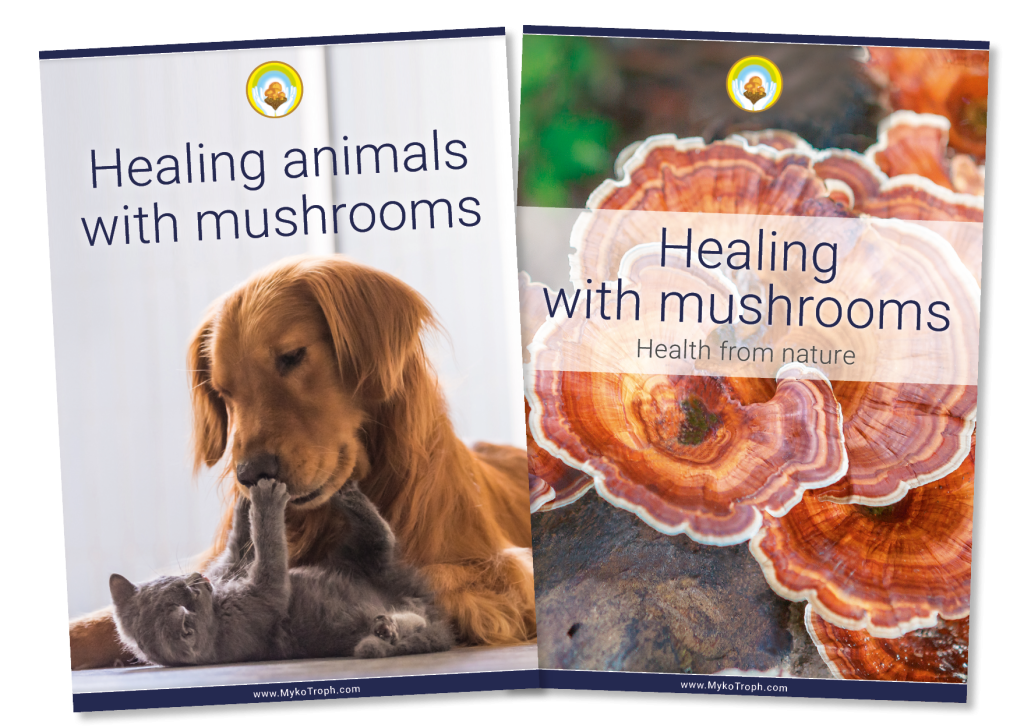
Each animal is unique!
Our experienced team will be happy to advise you in detail and free of charge on all matters relating to your pet’s health :
Treat leptospirosis effectively with vital mushrooms
Leptospirosis - a bacterial infectious disease and notifiable zoonosis
May 3, 2021
Petra Remsing – veterinary practitioner
Leptospirosis first appeared at a dog show. That was in Stuttgart in 1852. This is how the disease got its original name “Stuttgarter Hundeseuche”. In the meantime, this term is no longer used. About 30 years later, the first human case occurred. This was discovered by the physician Adolf Weil. That is why leptospirosis in humans is called Weil’s disease.
Leptospirosis is a bacterial infectious disease. It is common all over the world in various animal species: Dogs, wild and farm animals. In the case of wild animals, rats and mice are primarily affected, but also wild boars. Because transmission to humans is possible, leptospirosis is a zoonosis.
Partial reporting requirement
In the human sector, leptospirosis is a notifiable infectious disease according to § 7 IfSG. Accordingly, there is of course a treatment ban for alternative practitioners. For the animal sector, a notification requirement applies only to livestock, i.e. cattle, sheep and pigs. In dogs, horses and cats, the disease is not notifiable. This is also the reason why there are no exact figures on how many animals have actually fallen ill.
Simply request free information brochures now!

After you have sent the completed form, you will receive an e-mail with a download link.
Transmission routes of leptospirosis
The vectors are primarily mice and rats. They excrete the leptospires through their urine. The pathogens can survive in stagnant water and moist soil for 2-6 months. A prerequisite for this, however, is that the pH value is correct. It must be either slightly basic or neutral. Diluted urine is the ideal nutrient medium for leptospires.
Flooded meadows can be possible transmission sites. Many mice drowned there and the water is then contaminated with urine accordingly. When horses stand there, leptospires can enter the body through small skin lesions or soaked intact skin and mucous membranes. The same applies, of course, to dogs romping through flooded meadows or drinking the water and, of course, to people. When we walk through flooded meadows and water soaks our shoes, leptospires can enter through small skin lesions, soaked skin, or even intact skin.
Water ditches between meadows and fields are also possible transmission sites. Also, you can get infected when cleaning dog kennels or litter boxes. Here, be sure to first remove the urine undiluted. Horses can also ingest the leptospires through their feed, for example, when they are in wet or flooded pastures.
The risk of infection is highest at temperatures of 0-25° C, because these temperatures provide the optimal habitat for leptospires. Thus, the risk of infection is greatest in late summer into the fall or when we have flooding due to heavy rains. Below zero degrees, the survival time of leptospires shortens quite considerably and the risk of infection is low.
In addition to indirect transmission, however, direct transmission from animal to animal can also occur, for example directly via infected urine. It often happens, for example, that a dog “pees” on another dog during marking. There can also be transmission during mating. Pregnant dams can infect their young and, of course, infection is possible via bite wounds. For example, when cats engage in turf wars or when dogs get into fights.
Another source of infection is, of course, infected meat. When a cat chases and eats mice. Of course, this also applies to dogs that hunt and eat mice. Among dogs, hunting dogs are particularly at risk, for example, when they get break-up.

Each animal is unique!
Our experienced team will be happy to advise you in detail and free of charge on all matters relating to the health of your pet:
The disease in human
After an incubation period of 1-2 weeks, flu-like symptoms, headache, aching limbs, chills, and possibly a slowed heartbeat occur. During this time, the pathogens are detectable in the blood. After this fever phase, the fever drops again and a renewed rise in fever is seen at about the beginning of the second week. After that, the typical symptoms of leptospirosis occur. This is, for example, kidney inflammation, hepatitis or meningitis. The therapy that takes place with various antibiotics.
Leptospirosis in dogs
Immunocompromised dogs may experience severe general symptoms, such as abdominal pain. The animals vomit and suffer from weakness, later also fever. Young dogs usually fall ill most severely. The most common is an infestation of the kidneys. These swell and are thus less supplied with blood. This allows urinary substances to accumulate in the blood.
If mainly the liver is affected, severe dysfunction occurs with jaundice, i.e. icterus. In addition, the animals get vasculitis – an inflammatory disease of the blood vessels.
If the leptospires enter the central nervous system, meningitis occurs. In addition, the eyes may be affected, with inflammation of the medial meninges and retina. In the acute phase, damage to the lungs or heart may also occur. Infertility is possible or abortion in pregnant animals.
Once the disease is over, the pathogen can be excreted in the urine for several months to four years. The exact elimination period is not known.
Cats and horses
Cats have a high resistance to the disease and thus very rarely show clinical signs. Some animals show a disturbed general condition, occasionally fever may occur, jaundice or chronic kidney inflammation.
Acute leptospirosis is also rather rare in horses, but a high percentage of them are infected, i.e. the animals have had contact with the pathogen. In healthy horses, the infection is usually asymptomatic. When an animal becomes ill, symptoms include intermittent fever, jaundice, anemia, and kidney weakness. The animals are weakened in general condition, less efficient and have a stiff gait. Abortion may occur in pregnant animals.
In horses, there is another special form of leptospirosis, equine recurrent uveitis (ERU), also called periodic eye inflammation or moon blindness. It is a unilateral or bilateral inflammation of one or more parts of the medial eye skin. These inflammations may be chronic or may occur in recurrent episodes. This disease causes progressive damage to the eye and blindness.

Each animal is unique!
Our experienced team will be happy to advise you in detail and free of charge on all matters relating to the health of your pet:
The treatment of leptospirosis
It is treated with antibiotics, usually intravenously, especially if the animals vomit. This prevents the pathogen from multiplying and also from being eliminated. With timely treatment, approximately 50%-80% of adult dogs survive clinically manifested leptospirosis.
Depending on which organs are affected by the disease, additional symptomatic treatment is given: in the case of renal insufficiency, intravenous fluid therapy; in the case of insufficient urine production, diuretics are prescribed.
Therapy with vital mushrooms
Coriolus for strengthening the immune system
If we see that it is animals with a weakened immune system that contract leptospirosis, then it is important to modulate the immune system, i.e. to strengthen a cellular defense that is too weak. We can do this, for example, with the vital mushroom Coriolus. This fungus strengthens a weakened immune system and the defense system can better fight the bacteria.
Reishi - valuable vital mushroom
Reishi is also a valuable mushroom in leptospirosis, precisely because we also have an inflammatory event here. Reishi has the most triterpenes in the fruiting body and spores. These have a strong anti-inflammatory effect.
Cordyceps improves kidney function
In addition to the liver, leptospirosis often affects the kidneys. And this is where cordyceps in particular is valuable. Cordyceps has a very big connection with the kidneys. It improves renal function and also creatinine clearance. It increases kidney energy and, of course, also has a very strong relation to the immune system. It also generally supports liver metabolism. A truly versatile mushroom.
The vital mushroom Agaricus blazei murrill (ABM)
For leptospirosis, it is always best given along with ABM, which is Agaricus Blazei Murrill. This has a very strong regulating effect on the immune system. Thus, the intracellular pathogens can be better eliminated. And ABM does much more: it stimulates blood formation in the bone marrow and detoxifies the liver quite moderately.
Like all fungi, it also maintains antioxidant enzymes, such as superoxide dismutase (SOD). This enzyme destroys superoxide radicals, protecting cells from free radicals.
Pleurotus - important fungus for healthy intestinal flora
Since animals with leptospirosis are given different types of antibiotics, it is of course useful to provide additional support for the immune system. 80% of the immune system is located in the intestine. Therefore, it is definitely important to rebuild the intestinal flora. Here, the fungus Pleurotus comes into question quite particularly.
Pleurotus is able to rebalance the intestinal bacteria. It supports the growth of probiotic bacteria in the intestinal mucosa and it increases the production of lactobacilli, of enterococci and of bifiobacteria. Pleurotus also has a liver-protective and a strong antibiotic effect. The antibiotic pleurotin is obtained from this fungus.
Other herbal support
Besides vital mushrooms, of course, you can support the animals with other means, for example, with various medicinal plants and antioxidants. Very effective antioxidants are the OPC (oligomeric procyanidins). They fight free radicals and are particularly suitable for all inflammatory processes.
Equally valuable is the nettle. It is quite excellent medicinal plant with strengthening effect on the immune system. Nettle has many antioxidants, anti-inflammatory action and analgesic properties.
For mushroom powders there are many suppliers
You will find trustworthy suppliers with controlled organic cultivation in Germany, but unfortunately also less recommendable importers of cheap goods. Read what is important when buying.
DO YOU HAVE ANY QUESTIONS?
We will gladly take time for you. In our free consultation we answer individually and personally all your questions about the health of your pet under:
